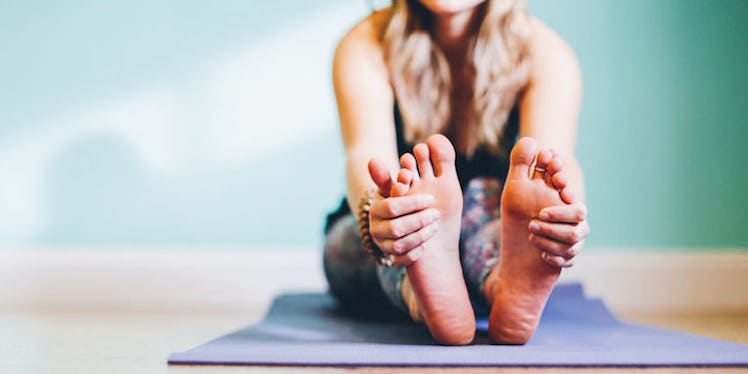
Here's Why It May Not Be A Good Idea To Do Yoga Barefoot, According To An Expert
Yoga is traditionally done barefoot, and most yogis would probably cringe at the thought of wearing shoes or even socks during their practice. #FreeTheFoot, amirite people? In all seriousness, though, you're probably really accustomed to doing yoga barefoot and don't even give it a second thought at this point — but that might not always be the best idea, according to at least one expert.
I don't know about you, but I think there's something very liberating about being barefoot, whether it's during yoga or even when you're just hanging out around the house. It's comfortable, it's freeing, and personally, I feel like the most graceful version of myself whenever I'm barefoot. But according to Dr. Jackie Sutera, DPM, a podiatrist, Vionic Innovation Lab expert, and American Podiatric Medical Association spokesperson, doing yoga sans socks or shoes could potentially be a bad idea, depending on both your body, and whether or not you're taken the right precautionary measures.
"When you're barefoot, you rely on the intrinsic or small muscles in the foot for balance," Dr. Sutera tells Elite Daily over email. "The fat on the bottom of your foot is the only cushion between your foot bones and the floor." In other words, you know those one-legged yoga poses that test your balance, like tree pose? According to Sutera, putting all your weight on such a small group of muscles might not be a great idea, as it could increase your chances of injury. "All these small muscles are contracted and you're exerting force with all your bodyweight on your feet," she explains. Ouch.
The thing is, Sutera says, you're most likely to experience this barefoot discomfort during yoga if you're just starting out with the practice, or if you don't practice that often in general. “Pain in feet can come from overuse and doing a new exercise," she tells Elite Daily. For most people, though, Sutera says, any pain you feel will likely subside on its own over time, provided you're not already recovering from or dealing with any related injuries. The podiatrist says it's really older people, people with bunions (aka bumps that can form on the base joint of your big toe), and again, anyone who's either new to yoga or recovering from an injury, who should proceed with the most caution here.
The most common barefoot yoga injuries, according to Sutera, include inflammation, sprains, strains, and pinched nerves. Not a fun time, fam. Namastay away from that blasphemy. And what's worse, the podiatrist adds, the barefoot yoga struggles aren't simply limited to foot pain. Sutera says being barefoot during yoga, depending on where exactly you're practicing, could also make you more susceptible to picking up contagious skin viruses that may cause plantar warts which, according to the Mayo Clinic, are "small growths that usually appear on the heels or other weight-bearing areas of your feet." No thank you.
So how can you stay careful and safe if you do decide to practice yoga barefoot? According to Sutera, if you start to feel pain in your foot in the middle of a class, it's important to stop immediately and rest for a bit. "Sit down, stretch, and massage the area," she advises. "Wait until the pain subsides, and really be honest about whether you should jump back into class — don't try to just work through it.”
After that, she says, be sure to wait a day or so before practicing yoga again. If the pain returns, becomes worse, or persists, Sutera says it's best to see your doctor about it.
Prevention-wise, before yoga classes, Sutera says it can be helpful to stretch the arches of your feet and warm up by practicing some of the movements you know you'll be doing during the class — tree posers, unite! "After a few classes and slowly over time, your feet should get used to some of the motions as your foot muscles get stronger," she explains.
And as for avoiding those skin viruses, the podiatrist suggests steering clear of rental studio mats in your yoga classes. Instead, bring your own mat just to be safe, and be sure to clean it with a sanitizing wipe after each use.
"Also, [remember to] use clean flip flops or socks when walking around the studio," Sutera says. Barefoot and buck-wild might sound appealing, but pinched nerves and plantar warts sure don't. Stay safe out there, yogis.